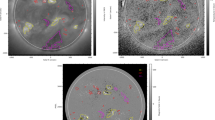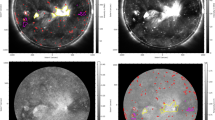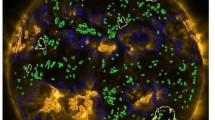Abstract
It is of great interest and importance to study the variabilities of solar EUV, UV and X-ray irradiance in heliophysics, in Earth’s climate, and space weather applications. A careful study is required to identify, track, monitor and segment the different coronal features such as active regions (ARs), coronal holes (CHs), the background regions (BGs) and the X-ray bright points (XBPs) from spatially resolved full-disk images of the Sun. Variability of solar soft X-ray irradiance is studied for a period of 13 years (February 2007–March 2020, covers Solar Cycle 24), using the X-Ray Telescope on board the Hinode (Hinode/XRT) and GOES (1 – 8 Å). The full-disk X-ray images observed in Al_mesh filter from XRT are used, for the first time, to understand the solar X-ray irradiance variability measured, Sun as a star, by GOES instrument. An algorithm in Python has been developed and applied to identify and segment coronal X-ray features (ARs, CHs, BGs, and XBPs) from the full-disk soft X-ray observations of Hinode/XRT. The segmentation process has been carried out automatically based on the intensity level, morphology and sizes of the X-ray features. The total intensity, area, and contribution of ARs/CHs/BGs/XBPs features were estimated and compared with the full-disk integrated intensity (FDI) and GOES (1 – 8 Å) X-ray irradiance measurements. The XBPs have been identified and counted automatically over the full disk to investigate their relation to solar magnetic cycle. The total intensity of ARs/CHs/BGs/XBPs/FD regions are compared with the GOES (1 – 8 Å) X-ray irradiance variations. We present the results obtained from Hinode/XRT full-disk images (in Al_mesh filter) and compare the resulting integrated full-disk intensity (FDI) with GOES X-ray irradiance. The X-ray intensity measured over ARs/CHs/BGs/XBPs/FD is well correlated with GOES X-ray flux. The contributions of the segmented X-ray features to FDI and X-ray irradiance variations are determined. It is found that the background and active regions have a greater impact on the X-ray irradiance fluctuations. The mean contribution estimated for the whole observed period of the background regions (BGs) will be around \(65\pm10.97\%\), whereas the ARs, XBPs and CHs are \(30\pm11.82\%\), \(4\pm1.18\%\) and \(1\pm0.52\%\), respectively, to total solar X-ray flux. We observed that the area and contribution of ARs and CHs varies with the phase of the solar cycle, whereas the BGs and XBPs show an anti-correlation. We find that the area of the coronal features is highly variable suggesting that their area has to be taken into account in irradiance models, in addition to their intensity variations. The time series results of XBPs suggest for an existence of anti-correlation between the number of XBPs and the sunspot numbers. It is also important to consider both the number variation and the contribution of XBPs in the reconstruction of total solar X-ray irradiance variability.







Similar content being viewed by others
References
Acton, L.W., Weston, D.C., Bruner, M.E.: 1999, Deriving solar X ray irradiance from Yohkoh observations. J. Geophys. Res. 104, 14827. DOI. ADS.
Acton, L.W., Culhane, J.L., Gabriel, A.H., Bentley, R.D., Bowles, J.A., Firth, J.G., Finch, M.L., Gilbreth, C.W., Guttridge, P., Hayes, R.W., Joki, E.G., Jones, B.B., Kent, B.J., Leibacher, J.W., Nobles, R.A., Patrick, T.J., Phillips, K.J.H., Rapley, C.G., Sheather, P.H., Sherman, J.C., Stark, J.P., Springer, L.A., Turner, R.F., Wolfson, C.J.: 1980, The soft X-ray polychromator for the Solar Maximum Mission. Solar Phys. 65, 53. DOI. ADS.
Alipour, N., Safari, H.: 2015, Statistical properties of solar coronal bright points. Astrophys. J. 807, 175. DOI. ADS.
Arish, S., Javaherian, M., Safari, H., Amiri, A.: 2016, Extraction of active regions and coronal holes from EUV images using the unsupervised segmentation method in the Bayesian framework. Solar Phys. 291, 1209. DOI. ADS.
Aschwanden, M.J.: 1994, Irradiance observations of the 1 – 8 Å solar soft X-ray flux from goes. Solar Phys. 152, 53. DOI. ADS.
Bailey, S.M., Woods, T.N., Barth, C.A., Solomon, S.C., Canfield, L.R., Korde, R.: 2000, Measurements of the solar soft X-ray irradiance by the Student Nitric Oxide Explorer: first analysis and underflight calibrations. J. Geophys. Res. 105, 27179. DOI. ADS.
Bailey, S.M., Woods, T.N., Eparvier, F.G., Solomon, S.C.: 2006, Observations of the solar soft X-ray irradiance by the Student Nitric Oxide Explorer. Adv. Space Res. 37, 209. DOI. ADS.
de Wit, T.D.: 2006, Fast segmentation of solar extreme ultraviolet images. Solar Phys. 239, 519. DOI. ADS.
Dere, K.P., Horan, D.M., Kreplin, R.W.: 1974, The spectral dependence of solar soft X-ray flux values obtained by SOLRAD 9. J. Atmos. Terr. Phys. 36, 989. DOI. ADS.
Dorotovic, I., Coelho, A., Rybak, J., Mora, A., Ribeiro, R., Kusa, W., Pires, R.: 2018, Automatic detection and tracking of coronal bright points in SDO/AIA images. Sun Geosph. 13, 129. DOI. ADS.
Foukal, P., Lean, J.: 1988, Magnetic modulation of solar luminosity by photospheric activity. Astrophys. J. 328, 347. DOI. ADS.
Giono, G., Zender, J.J., Kariyappa, R., Damé, L.: 2021, Origin of the solar rotation harmonics seen in the EUV and UV irradiance. Solar Phys. submitted.
Golub, L., Deluca, E., Austin, G., Bookbinder, J., Caldwell, D., Cheimets, P., Cirtain, J., Cosmo, M., Reid, P., Sette, A., Weber, M., Sakao, T., Kano, R., Shibasaki, K., Hara, H., Tsuneta, S., Kumagai, K., Tamura, T., Shimojo, M., McCracken, J., Carpenter, J., Haight, H., Siler, R., Wright, E., Tucker, J., Rutledge, H., Barbera, M., Peres, G., Varisco, S.: 2007, The X-Ray Telescope (XRT) for the Hinode mission. Solar Phys. 243, 63. DOI. ADS.
Hall, L.A., Hinteregger, H.E.: 1970, Solar radiation in the extreme ultraviolet and its variation with solar rotation. J. Geophys. Res. 75, 6959. DOI. ADS.
Hara, H., Nakakubo-Morimoto, K.: 2003, Variation of the X-ray bright point number over the solar activity cycle. Astrophys. J. 589, 1062. DOI. ADS.
Hara, H., Nakakubo-Morimoto, K.: 2004, In: Sakurai, T., Sekii, T. (eds.) Variation of the X-Ray Bright Point Number over the Solar Activity Cycle, Astronomical Society of the Pacific Conference Series 325, 307. ADS.
Kariyappa, R.: 1999, Quiet-Sun variability with the solar cycle. In: Rimmele, T.R., Balasubramaniam, K.S., Radick, R.R. (eds.) High Resolution Solar Physics: Theory, Observations, and Techniques, Astronomical Society of the Pacific Conference Series 183, 501. ADS.
Kariyappa, R.: 2000, CaII K imaging to understand UV irradiance variability. J. Astrophys. Astron. 21, 293. ADS.
Kariyappa, R.: 2008a, Solar coronal rotation determined by X-ray bright points in Hinode/XRT and Yohkoh/SXT full-disc images. Astron. Astrophys. 488, 297. DOI. ADS.
Kariyappa, R.: 2008b, Spatially resolved images and solar irradiance variability. J. Astrophys. Astron. 29, 159. DOI. ADS.
Kariyappa, R., DeLuca, E.: 2012, Coronal rotation from XBPs observed with Hinode/XRT. In: Golub, L., De Moortel, I., Shimizu, T. (eds.) Fifth Hinode Science Meeting, Astronomical Society of the Pacific Conference Series 456, 207. ADS.
Kariyappa, R., Pap, J.M.: 1996, Contribution of chromospheric features to UV irradiance variability from spatially-resolved CA II K spectroheliograms. Solar Phys. 167, 115. DOI. ADS.
Kariyappa, R., Sivaraman, K.R.: 1994, Variability of the solar chromospheric network over the solar cycle. Solar Phys. 152, 139. DOI. ADS.
Kariyappa, R., Sivaraman, K.R., Anadaram, M.N.: 1994, Heating of the quiet solar chromosphere – part one. Solar Phys. 151, 243. DOI. ADS.
Kariyappa, R., Varghese, B.A.: 2008, Intensity oscillations and heating of the coronal X-ray bright points from Hinode/XRT. Astron. Astrophys. 485, 289. DOI. ADS.
Kariyappa, R., Deluca, E.E., Saar, S.H., Golub, L., Damé, L., Pevtsov, A.A., Varghese, B.A.: 2011, Temperature variability in X-ray bright points observed with Hinode/XRT. Astron. Astrophys. 526, A78. DOI. ADS.
Kosugi, T., Matsuzaki, K., Sakao, T., Shimizu, T., Sone, Y., Tachikawa, S., Hashimoto, T., Minesugi, K., Ohnishi, A., Yamada, T., Tsuneta, S., Hara, H., Ichimoto, K., Suematsu, Y., Shimojo, M., Watanabe, T., Shimada, S., Davis, J.M., Hill, L.D., Owens, J.K., Title, A.M., Culhane, J.L., Harra, L.K., Doschek, G.A., Golub, L.: 2007, The Hinode (Solar-B) Mission: an overview. Solar Phys. 243, 3. DOI. ADS.
Kumara, S.T., Kariyappa, R., Dominique, M., Berghmans, D., Damé, L., Hochedez, J.F., Doddamani, V.H., Chitta, L.P.: 2012, Preliminary results on irradiance measurements from Lyra and Swap. Adv. Astron. 2012, 623709. DOI. ADS.
Kumara, S.T., Kariyappa, R., Zender, J.J., Giono, G., Delouille, V., Chitta, L.P., Damé, L., Hochedez, J.-F., Verbeeck, C., Mampaey, B., Doddamani, V.H.: 2014, Segmentation of coronal features to understand the solar EUV and UV irradiance variability. Astron. Astrophys. 561, A9. DOI. ADS.
Lean, J.: 1987, Solar ultraviolet irradiance variations – a review. J. Geophys. Res. 92, 839. DOI. ADS.
McIntosh, S.W.: 2007, On the mass and energy loading of extreme-UV bright points. Astrophys. J. 670, 1401. DOI. ADS.
McIntosh, S.W., Gurman, J.B.: 2005, Nine years of EUV bright points. Solar Phys. 228, 285. DOI. ADS.
Nakakubo, K., Hara, H.: 2000, Variation of X-ray bright point number over the solar activity cycle. Adv. Space Res. 25, 1905. DOI. ADS.
Ogawara, Y., Acton, L.W., Bentley, R.D., Bruner, M.E., Culhane, J.L., Hiei, E., Hirayama, T., Hudson, H.S., Kosugi, T., Lemen, J.R., Strong, K.T., Tsuneta, S., Uchida, Y., Watanabe, T., Yoshimori, M.: 1992, The status of Yohkoh in orbit: an introduction to the initial scientific results. Publ. Astron. Soc. Japan 44, L41. ADS.
Sattarov, I., Pevtsov, A.A., Hojaev, A.S., Sherdonov, C.T.: 2002, X-ray bright points and photospheric bipoles during cycles 22 and 23. Astrophys. J. 564, 1042. DOI. ADS.
Shahamatnia, E., Dorotovič, I., Fonseca, J.M., Ribeiro, R.A.: 2016, An evolutionary computation based algorithm for calculating solar differential rotation by automatic tracking of coronal bright points. J. Space Weather Space Clim. 6, A16. DOI. ADS.
Sivaraman, K.R.: 1984, Ca II K bright points and the solar cycle. Solar Phys. 94, 235. DOI. ADS.
Takeda, A., Yoshimura, K., Saar, S.H.: 2016, The Hinode/XRT full-Sun image corrections and the improved synoptic composite image archive. Solar Phys. 291, 317. DOI. ADS.
Vaiana, G.S., Krieger, A.S., Timothy, A.F., Zombeck, M.: 1976, ATM observations, X-ray results. Astrophys. Space Sci. 39, 75. DOI. ADS.
van der Zwaard, R., Berghmann, M., Zender, J., Kariappa, R., Giono, G., Damé, L.: 2021, Segmentation of coronal features to understand the solar EUV and UV irradiance variability III. Inclusion and Analysis of Bright points. Solar Phys. submitted.
Veselovsky, I.S., Zhukov, A.N., Dmitriev, A.V., Tarsina, M.V., Clette, F., Cugnon, P., Hochedez, J.F.: 2001, Global asymmetry of the Sun observed in the Extreme Ultraviolet Radiation. Solar Phys. 201, 27. ADS.
Viereck, R.A., Machol, J.L.: 2017, AGU Fall Meeting Abstracts #SH42A-06. ADS.
Worden, J.R., White, O.R., Woods, T.N.: 1998, Evolution of chromospheric structures derived from Ca II K spectroheliograms: implications for solar ultraviolet irradiance variability. Astrophys. J. 496, 998. DOI. ADS.
Zender, J.J., Kariyappa, R., Giono, G., Bergmann, M., Delouille, V., Damé, L., Hochedez, J.-F., Kumara, S.T.: 2017, Segmentation of photospheric magnetic elements corresponding to coronal features to understand the EUV and UV irradiance variability. Astron. Astrophys. 605, A41. DOI. ADS.
Zhang, Y.X., Fang, C., Ding, M.D., Livingston, W.C.: 2001, Quiet-Sun variability in a temperature minimum region. Astrophys. J. Lett. 547, L179. DOI. ADS.
Acknowledgements
Hinode is a Japanese mission developed and launched by ISAS/JAXA, in collaboration with NAOJ as a domestic partner, NASA and STFC (UK) as international partners. The Hinode science team at ISAS /JAXA has conducted the Scientific operation of the Hinode mission. This team mainly consists of scientists from different institutes in the partner countries. JAXA and NAOJ (Japan), STFC (UK), NASA (USA), ESA, and NSC (Norway) have provided the support for the post-launch operation. The Hinode team had contributed all their efforts in the design, build, and operation of the mission. RK wishes to express his sincere thanks to all members of ISEE for the support provided under Joint International Research Program. A part of these results were presented by RK at the PSTEP-4 International Symposium held at ISEE/Nagoya University from January 28 – 30, 2020 and his visit to this symposium has been supported by MEXT/JSPS KAKENHI Grant Number JP15H05816. The authors are thankful to the referee for the valuable comments and suggestions that improved the manuscript considerably.
Author information
Authors and Affiliations
Corresponding author
Ethics declarations
Disclosure of Potential Conflicts of Interest
The authors declare that they have no conflicts of interest.
Additional information
Publisher’s Note
Springer Nature remains neutral with regard to jurisdictional claims in published maps and institutional affiliations.
Rights and permissions
About this article
Cite this article
Adithya, H.N., Kariyappa, R., Shinsuke, I. et al. Solar Soft X-ray Irradiance Variability, I: Segmentation of Hinode/XRT Full-Disk Images and Comparison with GOES (1 – 8 Å) X-Ray Flux. Sol Phys 296, 71 (2021). https://doi.org/10.1007/s11207-021-01785-6
Received:
Accepted:
Published:
DOI: https://doi.org/10.1007/s11207-021-01785-6




